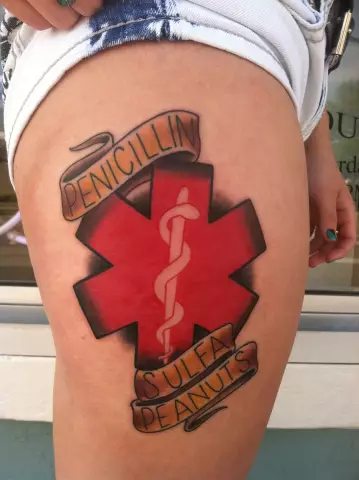- Author Rachel Wainwright [email protected].
- Public 2023-12-15 07:39.
- Last modified 2025-11-02 20:14.
About tattoos from a medical point of view

The fashion for tattoos is by no means new, it is one of the ancient methods of decorating your body, judging by the fact that they are done by people in tribes very remote from civilization. Like any fashion, this one is also subject to the ebb and flow. Currently, society is experiencing a boom in tattoo fashion, sometimes it seems that most of the townspeople go with them - this impression is especially strong in summer.
Tattoo from the point of view of psychology
Why do people get tattoos? This question has multiple answers. Firstly, a tattoo is information, a kind of stigma, which in some cases plays the role of identification, for example, among prisoners, Japanese yakuza, or in other communities that have preserved echoes of primitive customs. Why exactly a tattoo? Because this is something that cannot be taken away, lost, changed - and washed away too. That is, it is assumed that a certain characteristic is unchanged throughout a person's life. People whose life is subject to spontaneous events, is unstable and often depends on the will of other people (or gods, as in primitive tribes), need something permanent, something that belongs to them by right and cannot be taken away.
Ornamental tattoo, if you think about it, performs partly the same role, especially among young people. They need to declare themselves, to draw attention to themselves, to show that they have rights, at least the right to their own body.
There is a certain part of people who, unnecessarily, not belonging to closed communities and not investing an informational component in a tattoo, cover their body with abundant tattoos. Psychotherapists tend to believe that most of these people suffer from some form of mental disorder, feeling the need to damage their bodies over and over again. Self-harm without attempting suicide becomes an obsessive state for such people, and tattoos meet their needs as best as possible, since they are painful and leave traces reminiscent of the pain they have suffered.
Are tattoos safe?
From the point of view of medicine, none of the tattoos can be considered completely safe, no matter what objections are put forward by the masters of tattoo parlors. It is another matter that the immune system of most people is able to cope with this danger, but after all, it cannot be known in advance how strong the body's defense is at a given moment in this or that person, and whether it will come back to haunt him later.
The adverse effects of tattoos mainly relate to two points: the introduction of infection into the body and the ingestion of toxic substances into the bloodstream that cause allergic reactions. As for the first, everything is more or less clear here: you need to take a responsible approach to the choice of a tattoo parlor and a master, making sure that the tool with which the tattoo is applied is thoroughly sterilized. It is important that at the time of tattooing the skin does not have any inflammatory elements such as acne, pustules, unhealed wounds, etc. The skin should also be thoroughly cleansed before the procedure.
With allergies, everything is much more complicated. Allergic reactions are divided into two types: immediate and delayed type. Immediate manifestations appear immediately after exposure to the allergen, and delayed ones - as the immune response builds up to constant toxic exposure. This can happen in a week, a year, and even years later. Tattoo ink is a very strong allergic and toxic agent. Published studies by Canadian scientists claim that the tattoo fashion is responsible for the increased incidence of liver damage. It is not surprising, because it is on the liver that the function of cleaning the blood from the toxins contained in it lies. Published data says that inadequately sterilized tattoo needles cause thousands of people to contract viral hepatitis every year.which is known as the "silent killer", as it is often detected only at the stage of liver decay. Also, the liver bears the burden of eliminating toxic substances contained in the paint, which, as you know, remains in the body forever.
If you are still willing to take the risk and think that it is worth it, consider the following fact: the most poisonous is black ink for a tattoo, but it is a little easier to destroy than others, in case you ever want to get rid of it.
How to remove a tattoo
When tattooing, the needles pierce the skin at a distance of approximately 3mm from the surface. Thus, the paint is located outside the layer of skin cells, which, if damaged, regenerate completely without the formation of scar tissue. For this reason, removing a tattoo is very difficult, and sometimes impossible, without the formation of a cosmetic defect.

Removal of tattoos is carried out by the following methods:
- Mechanical. This is the simplest, most rude and most effective way. These are scarification, dermabrasion, surgical removal of a skin area containing dyes. The method is bad in that it is guaranteed to leave behind scars. Which is better - a scar or an already irrelevant tattoo, everyone decides for himself;
- A combination of mechanical and chemical methods. The bottom line is simple - after the surface layer of the skin, which is capable of regeneration, is polished off from the tattoo area, tampons soaked in saline are applied, which, penetrating deeper into the tissue, discolours the dye. The procedure is quite effective, but to achieve an acceptable result, it will have to be carried out more than once. Agree, even reading about it hurts. Of the minuses - trauma, soreness and the possibility that a weak drawing will still remain if the ink has penetrated deep enough;
- By laser method. Today it is one of the most effective and safe. Briefly, the essence can be described as follows: the skin at the tattoo site is exposed to an intense light flux (laser). Dark tissues absorb photons of light, and since there is an excess of them, the tissue containing the dark pigment is destroyed and subsequently excreted from the body. Laser treatment is less painful than other methods, and does not leave behind skin defects. However, even to remove a small tattoo will require more than one procedure, but several, but in the case when the tattoo is large, you will have to be patient and go through a fairly long course of laser therapy. The disadvantages of this method include the fact that not all dyes lend themselves well to such an effect, and therefore colored tattoos cannot always be removed in this way. Black and blue colors absorb light best.
According to statistics, 50% of people who have adorned themselves with a tattoo take measures to remove it within 10 years. How many of those who regret getting a tattoo do not make these attempts due to their rather high cost, by the way, much higher than getting a tattoo even in a good salon, unfortunately, is unknown.
Found a mistake in the text? Select it and press Ctrl + Enter.






